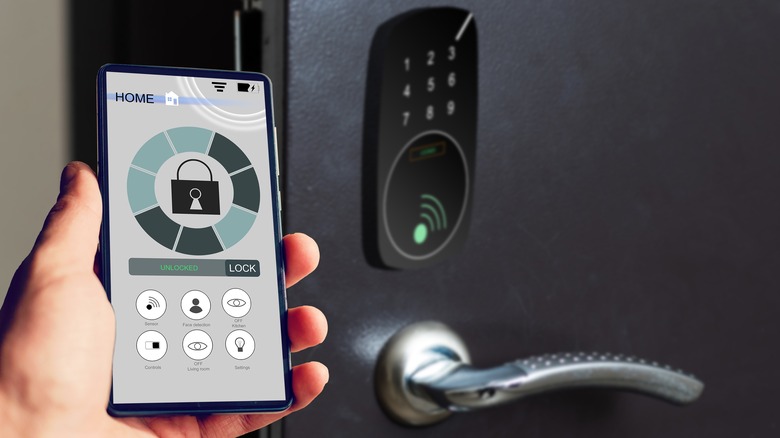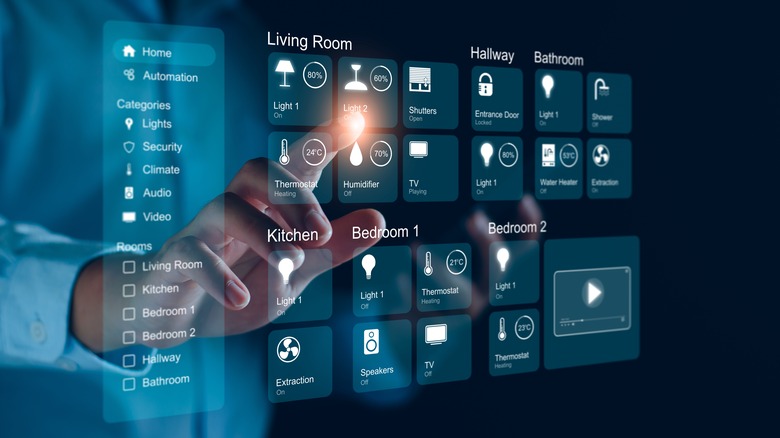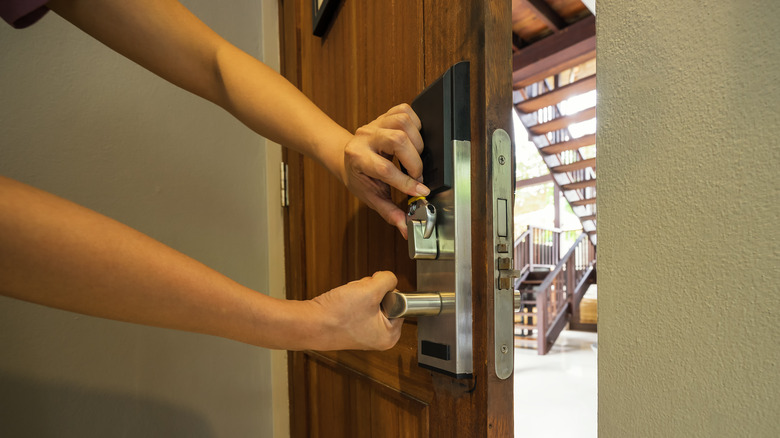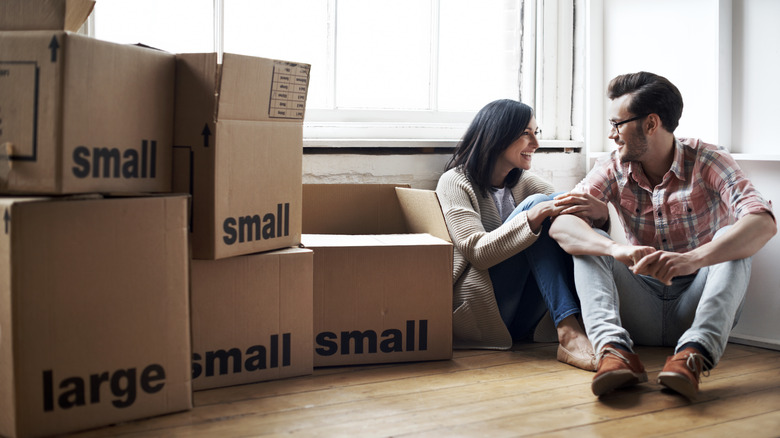11 Reasons To Add Smart Locks To Your Home
Locks operated with keys were first invented 4,000 years ago in Ancient Egypt. These locks were far simpler than today's, but their operating principles were the same. Is it any wonder that most of the locks on our doors today are not that secure or smart? In the Middle Ages, people experienced a lock-picking plague. In response, mechanical locks became more and more complex, like an early arm's race. Today, many of our mechanical locks are experiencing their own version of a lock-picking plague called lock bumping.
Most of the newer, more expensive mechanical locks are harder to bump or pick than locks that are several years old but still not completely safe. If it takes a key, it can be picked. The only question is how hard it is to pick.
Periodically, there's news about smart locks being hacked through their Bluetooth or Wi-Fi connections. This is the reality for all networked computers and smart devices. However, a properly installed and maintained smart lock, if it can be hacked by an intruder, will require a great deal of specialized computer skill and access to hack it. In comparison, your mechanical lock can sometimes be picked or bumped with almost no skill.
While nothing is foolproof, out of all the different types of locks, only smart locks come with greater security, convenience, ease of installation, lower total cost of ownership, smart home integration, and peace of mind. Isn't it time to teach your 4,000-year-old locks some new tricks?
Smart locks can protect you from yourself
Have you ever come home to discover one of your doors was unlocked? How often have you gotten a block from your home and turned around to go back to ensure all the doors are locked? Have your kids ever forgotten to lock the door? With a smart lock, the next time you're worried about whether you secured all the doors, all you have to do is check an app on your phone and remotely lock it if it's unlocked. Not to mention – installing a smart lock with an outdoor keypad will make it almost impossible to get locked out.
You can even enable the auto-lock features of your smart lock. Many smart locks have a geofencing feature that queries your smartphone's location using a combination of Bluetooth, Wi-Fi, and your phone's GPS. The result of all this technological magic is that when you approach the door, it unlocks, and when you walk away, it locks. What could be simpler? Just don't leave your smartphone by the front door, or you could be in for a bad surprise with some locks that use only Bluetooth!
Keep in mind, however, that using auto-lock functions with certain combinations of phones or smart locks can result in failures to lock or unlock automatically. Always check that the auto-lock function works. However, some smart locks go the extra mile and warn you that your door's unlocked when you're not at home.
Sleep soundly knowing your loved ones are safer
When it comes to keeping your family and home safe, a chain is only as strong as its weakest link. What do you do when you're locked out? You call a locksmith to pick your lock. If a locksmith can pick it, so can someone with darker motives. Smart locks or other types of pick-proof locks are a critical component in any modern security system.
All it takes to quickly pick vulnerable locks is a bump key. Sprees of lock bumping have been reported in the press, and while picking a lock using a bump key may seem James Bond-like, it's not. Bumping is a less skilled form of lock picking, and a bump key is readily available online. Locksmiths will tell you that most BHMA or ANSI Grade 1 certified locks are extremely hard to pick and impossible to bump, while lock-picking experts will tell you a very different tale. Why risk it when a 100% keyless smart lock is impossible to mechanically pick or bump?
Yet, not all smart locks are keyless. Many employ that 4,000-year-old key as a backup. While keyed smart locks are not as secure, they still provide better-layered security than conventional locks. Like all smart locks, they keep audit trails, issue tamper alerts, and can be remote-controlled. They can also better ensure you lock your door, but most importantly, they give you control over your digital keys. With a smart lock, you can instantly deactivate the passcode you gave to the babysitter you just fired. Try doing that with any keyed lock.
With smart locks you can have it your way
Smart locks can be tailored to your lifestyle while providing conveniences you cannot get with other locks. You can operate smart locks using a phone or webpage from anywhere in the world. When you walk up to your door, you can open it with a keypad, smart assistant voice commands, your fingerprint, smartphone or smartwatch proximity, smartphone or smartwatch command, keycards, fobs, or even that 4,000-year-old backup key. If that's not enough and you have a larger budget, you can even get a smart lock that uses facial recognition.
You can also go in the other direction and choose a smart lock that offers fewer ways to operate to save some money or make the installation easier. One thing to keep in mind is that if you do get a smart lock that does not have an outdoor keypad, you will be sacrificing some of the more useful capabilities of smart locks. A quality smart lock that does not have a backup mechanical key will not leave you out in the cold if the battery dies. Virtually almost all keyless locks provide a way to temporarily apply a battery – often a 9V — to contacts on the outside of the lock.
Smart locks are also smart integrators
Smart locks can be integrated with compatible smart home assistants and alarm systems using Wi-Fi, Z-Wave, or Bluetooth. This integration opens a wide range of advanced functionality. With this integration, all your doors can be remotely or programmatically locked and unlocked by your alarm or home assistant. They can also report the lock's status to you or your alarm monitoring company.
This kind of integration can teach your smart lock all kinds of new tricks, from smart assistant voice commands to programmed complex actions. This can go far beyond "Hey Siri, are all the doors locked?" or "Hey Siri, lock all doors." The alarm system could lock all unlocked doors if an outdoor motion detector is tripped. If door lock tampering is then detected, this could set off your alarm or switch on all the outside lights. You could also set up some systems to perform scheduled things like locking all doors at sundown.
With alarm or smart assistant integration, the only limit is your imagination and the capabilities of what else is connected to your alarm or smart assistant. Check out our guide to select the best home security system for your smart locks.
Smart locks are simple to install
Smart locks that attach to your existing deadbolt can be installed in a snap. As long as your door is compatible, smart locks that fully replace your existing deadbolt will take a little more time to install but are still easy. On the other hand, if you're replacing an antique lock, a non-standard lock, a surface deadbolt, or a lock with an integrated doorknob or handle, you may need to hire someone to install your smart lock.
One thing to keep in mind is that the easiest locks to install may be missing some standard features. For example, most smart locks that attach to your existing deadbolt do not provide an integrated outdoor keypad. Without an outdoor keypad, you will lose all protection from being locked out unless you forget your keys but remember your iPhone!
As long as your door is a standard thickness and the deadbolt hole is 1 1/2 inches or 2 1/8 inches in diameter, replacing your deadbolt with a smart lock should not require any alterations to the door. The smart lock should fit into the existing holes. In this situation, the only difficulty you could run into is if the strike plate does not line up cleanly with the bolt.
Smart locks can even save you money
It may be hard to imagine how you can add all the capabilities that smart locks bring to the table and also save money. While the difference in the purchase price is not that great between higher quality pick-resistant mechanical locks and smart locks, in general the price of a smart lock will usually be more than a mechanical lock. However, the savings with smart locks are in your total cost of ownership.
You will never have to rekey your locks or get new keys made. The average fee for a locksmith to come out and rekey your locks is at least $50, but more likely around $200. The average fee for an emergency call to pick a lock after you lock yourself out is about $150 to $250. This means avoiding a single instance of locking yourself or rekeying could pay for the smart lock.
Those are the hard costs, but some costs are harder to pin down. The average price to make new keys is not very much, but the hour or two wasted getting those keys made is incalculable. Also, what is the emotional cost of locking yourself out or the emotional and all too actual physical toll of a break-in? Investing in Smart Locks is like purchasing an insurance policy with all kinds of extra conveniences. What can be smarter than that?
Smart locks are becoming harder to hack
While nothing that is computer-based is completely hackproof, with every passing year, smart locks are becoming more sophisticated and harder to hack amid a landscape of everchanging threats. As always, to get the most from any smart lock, it's important to implement the best security practices possible.
When smart locks were first integrated with smart home assistants, many new capabilities became possible, but this added complexity also created new pathways for bad actors to hack your front door. One unintended consequence was that a would-be intruder could use voice commands to order Siri or Alexa to unlock the door through an open window. Smart home assistant manufacturers nipped this in the bud by requiring authentication with either a PIN or voice recognition — or both.
It seems like a month does not go by without a new hack being reported. Thankfully, most of these hacks are far too complex for your average home invader. They typically involve exploiting weaknesses in communications protocols and can require exotic tools such as ultrasonic transducers or modulated low-power lasers.
A newer breed of smart locks was released last year that supports Apple Home Key, which utilizes NFC. In theory, NFC is more secure than other means of transmitting commands, such as Bluetooth or Wi-Fi. These enhancements are due to NFC's built-in security protocols, its 1.5-inch proximity requirement, and the fact that it does not emit radio waves — a weak point of smart security systems in the past.
Smart locks will not slow down emergency exits
In the midst of panic caused by a fire or some other emergency, the last thing you'll want to do is fumble with a keypad or your smartphone to get out. With few exceptions, all smart locks can function purely mechanically on the interior side of the door by rotating the deadbolt's thumb-turn or knob, just like your 4,000-year-old lock. If your smart locks are integrated with a home security system, you could even configure the security system to unlock the doors when a fire or other hazard is detected.
Construction regulations for multi-family homes are typically stricter than for single-family homes. As a result, smart locks approved for multi-family dwellings will be safer in an emergency. Even though all smart locks can be manually operated, if fire is a major concern, then it might be wise to purchase a lock that has UL Fire Resistance Certification. This is especially true if the lock is going to be installed on a fire door.
You can take it with you
Smart locks can be an expensive investment, and that cost goes up if your home has several outside doors. If you are renting and installing a smart lock that does not alter the door, then it's easy to take it with you when you move. Your lease may have rules about leaving the lock behind, but most landlords will give you permission. You should ask before installing anything you plan on taking with you.
Smart locks that fit over the existing deadbolt and attach with double-sided tape are ideal for renters. SwitchBot makes these kinds of locks. This type of smart lock can also work with the widest range of deadbolts and night latches. The next best lock would be something that only alters the interior of the door, such as those made by August.
While these types of smart locks are ideal for renters thinking about moving, you may lose some features you want with this configuration. For example, you will not be able to use a keypad on the exterior of the door or an NFC key reader unless those required exterior components can be attached with double-sided tape and the associated risk of theft is acceptable. On the positive side of the ledger, in return for this possible loss of features, you will gain simplicity of installation.
Smart locks will make it easier to sell your house
While smart locks may not necessarily raise your property value, they will, at the very least, give you the kind of key control that makes showings easier and more worry-free. The realtor can be given a unique code that is used only to show the house. You could even give different codes to each realtor on the team or email realtors a single-use access code before each showing.
Let's face it. Most people do not like showing their home. Some of those strangers poking around in your life could even have ill intent. With a smart lock, you can track comings and goings. You will know when the showing is over and you can return home. You will also know if someone uninvited returns later.
Smart locks are also a relatively inexpensive home improvement that can make a good first impression on potential home buyers. This impression can then extend far beyond a high-tech way to get inside. If the lock is integrated with a smart assistant or another type of automation device, the system can be programmed to trigger a series of events when the prospective buyer walks in. All the lights could be switched on, electric window coverings could open, and more. This kind of showmanship could leave a powerful, lasting impression.
Smart locks look great
There are a lot of styles and looks to choose from. You can go as high-tech as your heart desires or as traditional and low-tech as your architecture requires. The highest security locks that are 100% keyless will require, at a minimum, a keypad or fingerprint scanner on the outside of the door. Locks that use facial recognition may include an outdoor color touchscreen.
Smart locks that fit over the existing deadbolt, such as SwitchBot, will look totally unchanged from the outside. Smart locks that replace only the interior thumb-latch, such as August, will also look completely stock on the outside. Another great lock to consider if you want the traditional look is the Level Lock.
On the opposite end of the spectrum, smart locks that replace both the inside and outside of a deadbolt, such as those made by Ultraloq or Schlage, will give you the most flexibility and options for appearance. There are also locks that have integrated video doorbells, such as the Eufy S330, as well as smart locks with integrated doorknobs like the Ultraloq Latch 5.











